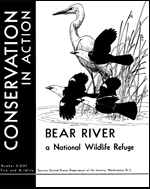United States Fish and Wildlife Service

United States Fish and Wildlife Service: Publications
Date of this Version
1-2013
Citation
U.S. Fish and Wildlife Servic, January 2013
Abstract
What is Gunnison sage-grouse? Description: Gunnison sage-grouse (Centrocercus minimus) are charismatic birds known for their elaborate mating ritual where males congregate on leks (breeding grounds) and strut, or “dance”, to attract mates. Leks are typically open areas with short vegetation within sagebrush habitats, often located on broad ridges, benches, or valley floors where visibility and hearing acuity are optimal. Gunnison sage-grouse are most easily identified by their large size, dark brown color, distinctive black bellies, long, pointed tails, and association with sagebrush habitats. During the breeding season, males have conspicuous filoplumes (specialized neck feathers), a black bib on a white upper breast, and yellow-green air sacs on the chest.
Taxonomy In 2000, Gunnison sage-grouse and greater sage-grouse (Centrocercus urophasianus) were recognized as separate species. This determination was based on differences in physical, genetic, and behavioral characteristics, as well as geographic isolation, between the two species.
Habitat Sage-grouse are considered obligate users of sagebrush and require large, contiguous areas of sagebrush across the landscape for long-term survival. Several species of sagebrush provide the specific food, cover, and reproduction habitats critical for sage-grouse survival. Loss and fragmentation of sagebrush habitats are chief causes in the decline of Gunnison and greater sage-grouse populations.
Range The historic and current distribution of Gunnison sage-grouse closely matches the distribution of sagebrush habitats. The current range of Gunnison sage-grouse is limited to seven population areas in southwestern Colorado and southeastern Utah. Approximately 940,000 acres (380,000 hectares) of habitat are occupied by the species. Of this, about 54 percent occurs on Federal lands; 41 percent occurs on private lands; and five percent occurs on state lands. Gunnison sage-grouse occupy approximately seven percent of the species’ potential historic range.
Population Size and Trends
The current range-wide population is estimated at 4,621 birds across the seven population areas. The Gunnison Basin population contains over 87 percent of the total number of birds and constitutes the largest remaining population. Population trends over the last 12 years indicate that the six smaller populations are in decline. The Gunnison Basin population trend has been stable over the same period.

